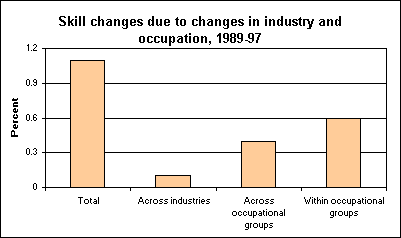An official website of the United States government
 United States Department of Labor
United States Department of Labor
Average skill levels in the economy increased over the 1989-97 period, primarily due to shifts in occupational employment within industries.

[Chart data—TXT]
A little over half of the total change was caused by shifts within broad occupational groups, within specific industries. An example of this might be a shift toward clerical supervisors and away from secretaries and data processors in the clerical occupations within the services industry.
About one-third of the increase could be traced to shifts within industries but across broad occupational groups. One example would be the trend toward hiring more professional workers and fewer clerical workers in a wide variety of industries.
Skill levels increased only slightly due to shifts toward higher-wage industries. Such across-industry shifts were mostly in the service-producing sector and accounted for about one-tenth of the total increase in the economy’s skill level.
The data used in this article were produced by the Occupational Employment Survey. Find out more in chapter 2 of Report on the American Workforce 1999 (PDF 1,037K).
Bureau of Labor Statistics, U.S. Department of Labor, The Economics Daily, Shifts within and across occupations drive changes in skill levels at https://www.bls.gov/opub/ted/1999/sept/wk3/art05.htm (visited January 08, 2026).

